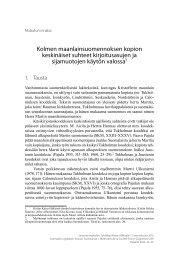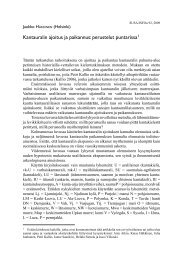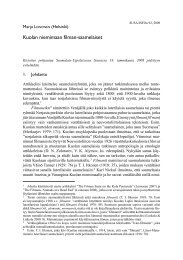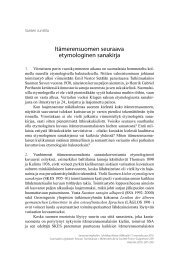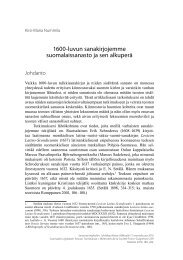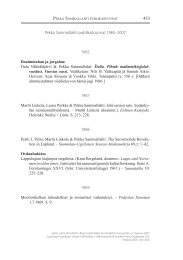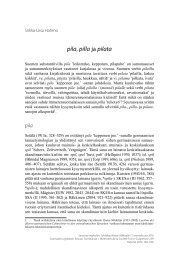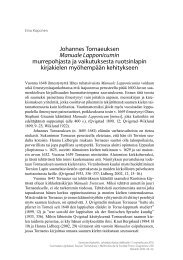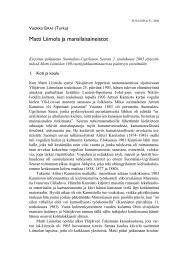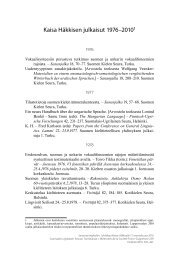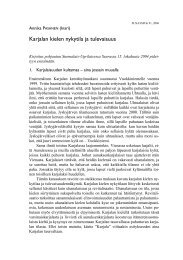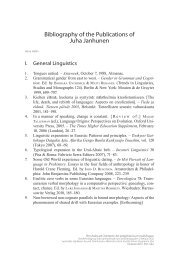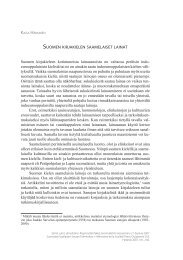On syntactic definition of finiteness: Evidence from Nivkh
On syntactic definition of finiteness: Evidence from Nivkh
On syntactic definition of finiteness: Evidence from Nivkh
Create successful ePaper yourself
Turn your PDF publications into a flip-book with our unique Google optimized e-Paper software.
Ekaterina GruzdevaUniversity <strong>of</strong> Helsinki<strong>On</strong> <strong>syntactic</strong> <strong>definition</strong> <strong>of</strong> <strong>finiteness</strong>:<strong>Evidence</strong> <strong>from</strong> <strong>Nivkh</strong>It is my pleasure and honour to present this article to Pr<strong>of</strong>essor Juha Janhunenon his 60 th birthday. <strong>On</strong> this occasion, I would like to thank him for introducingme to the world <strong>of</strong> Finnish linguistics almost twenty years ago.The article discusses the major problems involved in the study <strong>of</strong> the category<strong>of</strong> <strong>finiteness</strong>, based on data <strong>from</strong> the <strong>Nivkh</strong> language. After outliningthe general data on <strong>Nivkh</strong>, the paper discusses the <strong>syntactic</strong> approach to <strong>finiteness</strong>,according to which this category displays a three-way distinction <strong>of</strong> verbforms. The article then consecutively analyses <strong>Nivkh</strong> basic verb forms belongingto different classes, with special attention to their morphological properties.In conclusion, I present some generalizations concerning different approachesto <strong>finiteness</strong>.1. General data on <strong>Nivkh</strong><strong>Nivkh</strong> (isolate, Paleosiberian) is a moribund language currently spoken in severaldialects on Sakhalin Island and in the Amur region <strong>of</strong> Russia. Typologically,it is a polysynthetic head-final nominative language. The East Sakhalindialect, whose data is analysed in this paper, displays also some analytical features.The canonical word order is SOV. <strong>Nivkh</strong> has no adjectives, the relevantsemantic function being performed by qualitative verbs. An attribute togetherwith a head nominal as well as a primary object together with a head verb forma polysynthetic complex (in the examples, the parts <strong>of</strong> polysynthetic complexesare separated by a dash). The basic structure <strong>of</strong> a verb form may be representedas follows:OBJECT-root-TRANSITIVITY-ASPECT-CAUSATIVITY-ASPECT/TENSE-MODALITY-NEGATION-MOOD-NUMBER-FOCUSIn a single predicate-sentence, the verb almost invariably occurs sentence-finally.The minimal verb form is represented by a root and a mood suffix, cf. (1a).<strong>Nivkh</strong> has several moods, i.e. indicative, cf. (1), imperative, cf. (2), categorical,dubitative, preventive, etc. The language has two tenses, i.e. non-future, cf. (1a),Per Urales ad Orientem. Iter polyphonicum multilingue.Festskrift tillägnad Juha Janhunen på hans sextioårsdag den 12 februari 2012.Suomalais-Ugrilaisen Seuran Toimituksia = Mémoires de la Société Finno-Ougrienne 264.Helsinki 2012. 65–75.
66 Ekaterina Gruzdevaand future, cf. (1b). There are several aspects, i.e. inchoative/progressive, completive/intensive,resultative, etc.(1) a. Ñi ra-d. b. Ñəŋ ra-i-d-γun.I-[NOM] drink-IND-[SG] we:EXCL drink-FUT-IND-PL‘I drink/drank.’ ‘We (without you) will drink.’A multiple-predicate sentence is represented by a chain <strong>of</strong> <strong>syntactic</strong>ally dependentforms (= converbs) interlinked by various semantic relations (temporal, conditional,concessive, cause, purpose, manner, etc.), which is closed by an independentverb form, cf. (2) with a temporal converb um-inəŋ-anke ‘before gettingangry’, conveying posteriority, a temporal converb k‘əmlə-roř ‘after thinking’,indicating anteriority, and an independent imperative verb form it-ja ‘say’.(2) Um-inəŋ-anke urguř k‘əmlə-roř it-ja.be.angry-INT-CONV:TEMP well:2SG think-CONV:TEMP:2SG say-IMP:2SG‘Before getting angry, after thinking well, say.’2. The <strong>syntactic</strong> approach to <strong>finiteness</strong>According to the traditional view, the category <strong>of</strong> <strong>finiteness</strong> is treated as a morphologicalcategory that divides verb forms into two major classes, i.e. finiteforms that are characterized by person, number, tense, mood, etc. and non-finiteverb forms (such as infinitives, participles and converbs) that are typically notmarked for these categories. In addition to morphological criteria a <strong>syntactic</strong>criterion was used, based on the assumption that (i) only finite verbs are able t<strong>of</strong>orm an independent utterance, (ii) each independent utterance must have oneand only one finite verb, and (iii) non-finite verbs occur predominantly or exclusivelyin dependent contexts. Distributional and inflectional criteria definitelycorrelate with each other but may also conflict with each other, cf. Nikolaeva(2007: 2–3).Searching for a valid <strong>definition</strong> <strong>of</strong> <strong>finiteness</strong>, I came to the conclusion thatthe traditional morphological approach to this category is hardly applicable tothe analysis <strong>of</strong> <strong>Nivkh</strong> data, since in this language the morphological form <strong>of</strong> theverb is not a suitable criterion for establishing its finite/non-finite nature. As willbe seen <strong>from</strong> the following discussion, some <strong>of</strong> <strong>Nivkh</strong> converbs (presumablynon-finite forms) appear, <strong>from</strong> their morphological properties, to be “equallyfinite” or even “more finite” than, for instance, indicative verb forms that aretraditionally considered as finite. At the same time, the <strong>syntactic</strong> interpretation<strong>of</strong> <strong>finiteness</strong>, defined in terms <strong>of</strong> the <strong>syntactic</strong> functions performed by differentverb forms, allows us to draw quite a clear distinction between finite and nonfiniteverb forms in <strong>Nivkh</strong>.
<strong>On</strong> <strong>syntactic</strong> <strong>definition</strong> <strong>of</strong> <strong>finiteness</strong>: <strong>Evidence</strong> <strong>from</strong> <strong>Nivkh</strong>67From a <strong>syntactic</strong> perspective, <strong>finiteness</strong> is considered as the possibility thata verb form can be used as the only or the matrix predicate, regardless <strong>of</strong> markednessfor different morpho<strong>syntactic</strong> categories. Non-<strong>finiteness</strong> is therefore understoodas the impossibility <strong>of</strong> a verb form to appear in these <strong>syntactic</strong> functions,cf. Koptjevskaja-Tamm (1994: 1245) and Nedjalkov (1998: 421). Similar<strong>definition</strong>s are known to be used, for instance, for differentiation <strong>of</strong> independentand dependent verb forms, see e.g. Hengeveld (1998: 339)Furthermore, in a number <strong>of</strong> recent studies <strong>finiteness</strong> is analysed not as abinary but as a scalar phenomena dealing with different degrees <strong>of</strong> <strong>finiteness</strong>in terms <strong>of</strong> implicational-hierarchic scales, cf. Givón (1990: 853–854) and Hengeveld(1998). The <strong>syntactic</strong> approach to <strong>finiteness</strong> developed in this article alsoimplies the existence not only <strong>of</strong> a set <strong>of</strong> two absolute values, ‘finite’ vs. ‘nonfinite’,but <strong>of</strong> a hierarchy <strong>of</strong> <strong>finiteness</strong>. Such a compromise theoretical solutionto the representation <strong>of</strong> linguistic categories, which allows a continuum spaceboth within and between categories, is known to be a basis, for instance, for theprototypical (‘flexible’) categorial distribution presented in Givón (1984: 16).I treat the category <strong>of</strong> <strong>finiteness</strong> as a scale comprising two polar areas, ‘<strong>finiteness</strong>’and ‘non-<strong>finiteness</strong>’, whose members display functional characteristicproperties that were set earlier, and an in-between area. The in-between area,whose members share the features <strong>of</strong> the two polar areas, represents in turn acontinuum whose members gravitate towards one or another pole. The degree <strong>of</strong>closeness/remoteness <strong>of</strong> a particular verb form to/<strong>from</strong> the ‘finite’ or ‘non-finite’pole is determined by its prototypical, i.e. most common and textually frequent,and non-prototypical, i.e. less common and textually frequent, <strong>syntactic</strong> functions,see e.g. the <strong>definition</strong> <strong>of</strong> (proto)typicality in Givón (1986: 78–79) and Cr<strong>of</strong>t(1990: 125).Thus, relying on the given <strong>syntactic</strong> <strong>definition</strong> <strong>of</strong> <strong>finiteness</strong>, verb formscan be divided into the three classes: (1) finite forms, (2) non-finite forms, (3)in-between forms. The number <strong>of</strong> forms belonging to each <strong>of</strong> the three classesin <strong>Nivkh</strong> is roughly equal.In order to ground this <strong>syntactic</strong> approach to <strong>finiteness</strong>, I shall demonstratethat <strong>syntactic</strong> distinctions between finite, non-finite and in-between forms in<strong>Nivkh</strong> do not strictly correlate with their morphological properties, usually associatedwith <strong>finiteness</strong>/non-<strong>finiteness</strong>. The forms entering into one or anotherclass will be ranked according to their ability, first <strong>of</strong> all, to agree with the subjectin person and number and, secondly, to be marked for tense and aspect. Thehighest position in a hierarchy is occupied by a form that displays the largestnumber <strong>of</strong> morphological properties associated with <strong>finiteness</strong>.
68 Ekaterina Gruzdeva3. <strong>Nivkh</strong> finite verb formsThe finite forms that represent a polar class <strong>of</strong> the <strong>syntactic</strong> category <strong>of</strong> <strong>finiteness</strong>occur as predicates in single-predicate sentences or in matrix clauses <strong>of</strong>multiple-predicate sentences and cannot be used in other <strong>syntactic</strong> functions.<strong>Nivkh</strong> “pure” finite forms can be ranked as follows: assumptive negative forms(agreement in person and number, tense) > preventive forms (agreement in number)> interrogative forms (tense, aspect) > categorical forms, dubitative forms,etc.Assumptive negative forms are typically used in the future and indicatethat the situation will not take place, because it usually does not occur undersimilar circumstances. In the non-future, these forms are used in rhetoricalquestions. These forms are derived with the suffix rlo/tlo that occupies the sameposition as the mood suffixes. The forms demonstrate a limited differentiation<strong>of</strong> person and number <strong>of</strong> the subject, cf. Table 1, and are inflected for tense butnot for aspect, cf. (3):(3) a. Jaŋ ra-i-rlo. b. Ñi ra-i-tlo.he-[NOM] drink-FUT-NEG:ASS:3SG I-[NOM] drink-FUT-NEG:ASS:1SG‘He will not drink.’‘I shall not drink.’Preventive verb forms denote a speaker’s attempt to prevent undesirable consequences<strong>of</strong> the situation by means <strong>of</strong> appealing to a hearer. In <strong>Nivkh</strong>, these formsare attested only in the second person. They are specified by the number <strong>of</strong> thesubject (cf. Table 1) but are not marked for tense and aspect. <strong>Nivkh</strong> distinguishestwo types <strong>of</strong> preventives: (i) visual and (ii) assumptive.Visual preventives are used when a speaker observes some action performedby a hearer and tries to prevent the possible harmful consequences <strong>of</strong>this action. For instance, when the hearer(s) is/are going along a slippery roadand may fall, the speaker uses the forms given in (4):(4) a. Kuţ-inəŋra! b. Kuţ-inəŋta!fall-PREV:VIS:2SGfall-PREV:VIS:2PL‘Do not fall down! [you:SG]!’ ‘Do not fall down! [you:PL]!’Assumptive preventives are employed when the speaker does not directly observeany potentially harmful actions carried out by the hearer, but proceeding<strong>from</strong> the previous negative experience he or she assumes that in the future theseactions will take place. The forms presented in (5) are used in a situation wherethe speaker is giving a toy to the hearer(s):(5) a. Zosq-jaŋra! b. Zosq-jaŋta!break-PREV:ASS:2SGbreak-PREV:ASS:2PL‘Do not break [it] [you:SG]!’ ‘Do not break [it] [you:PL]!’
<strong>On</strong> <strong>syntactic</strong> <strong>definition</strong> <strong>of</strong> <strong>finiteness</strong>: <strong>Evidence</strong> <strong>from</strong> <strong>Nivkh</strong>69Interrogative verb forms basically do not show any subject agreement but taketense and aspect markers. They are derived either by the suffix l/lo occupyingthe same order as the mood marker, cf. (6a), or by the postfix la/lu which is attachedto the indicative form, cf. (6b). The last forms may optionally take theplural suffix indicating the plurality <strong>of</strong> the subject (see section 5.1).(6) a. Jaŋ vi-l? b. Jaŋ vi-i-d-la?he-[NOM] go-INTER‘Did he go?’he-[NOM] go-FUT-IND-INTER‘Will he go?’Categorical forms with the mood suffix γitlo/kitlo emphasize that the speaker isconfident about the statement, cf. (7a). Dubitative forms with the suffix jakna,on the contrary, indicate that the statement is doubtful or uncertain, cf. (7b).Neither categorical nor dubitative forms agree with the subject and they are notinflected for tense and aspect.(7) a. Jaŋ vi-γitlo. b. Jaŋ vi-jakna.he-[NOM] go-CATEG‘He certainly went.’he-[NOM] go-DUBIT‘He probably went.’4. <strong>Nivkh</strong> non-finite verb formsAnother polar class <strong>of</strong> the <strong>syntactic</strong> category <strong>of</strong> <strong>finiteness</strong> is represented by“pure” non-finite verb forms that cannot occur as predicates in single-predicatesentences or in matrix clauses <strong>of</strong> multiple-predicate sentences. <strong>Nivkh</strong> non-finiteforms can be ranked as follows: coordinated forms (agreement in person andnumber, tense, aspect) > participles (agreement in number, tense, aspect) > supineforms.Coordinated forms appear as predicates <strong>of</strong> coordinated clauses at least inpairs and therefore cannot be single or matrix predicates. Each coordinated formtakes the same set <strong>of</strong> suffixes ra/ta/na whose variants are chosen according tothe person and number <strong>of</strong> the subject and the tense/mood <strong>of</strong> verb forms, cf. Tables1 and 2. The chain <strong>of</strong> coordinated forms may be closed by the auxiliary verbha- ‘do so’ which is optional in the indicative and obligatory in other moods, cf.(8a–c). Coordinated forms freely take aspect markers.(8) a. Jaŋ əřk pil-ra vesqar-rahe-[NOM] already be.big-COORD:3SG be.strong-COORD:3SG(ha-d).do.so-IND-[SG]‘He is already big and strong.’
70 Ekaterina Gruzdevab. Ñi əřk pil-ta vesqar-ta (ha-d).I-[NOM] already be.big-COORD:1SG be.strong-COORD:1SG do.so-IND-[SG]‘I am already big and strong.’c. Ñi pil-na vesqar-na (ha-i-d).I-[NOM] be.big-COORD:1SG be.strong-COORD:1SG do.so-FUT-IND-[SG]‘I shall be big and strong.’Participles function as attributes and are represented by a verb stem that maytake the suffix ŋ. The plurality <strong>of</strong> the subject is marked by reduplication <strong>of</strong> theverb root, cf. (9a) and (9b). Moreover, participles display overt expressions <strong>of</strong>tense and aspect and take all corresponding verb suffixes.(9) a. ţosq-ŋ—mu b. ţosq-zosq-ŋ—mu-γunbreak-PTC—boat-[SG-NOM] break-break-PTC—boat-PL-[NOM]‘broken boat’‘broken boats’Two supine forms that signal the purpose <strong>of</strong> the action are derived with the dativesuffix toχ/roχ/doχ. The first supine has the subject coreferential with that <strong>of</strong>the head verb and attaches the dative suffix directly to the verb stem, cf. (10).The second supine form may have either the same subject, cf. (11a), or differentsubject, cf. (11b), as the head verb. The second supine always comprisesthe intentional suffix inə and nominalizer f. Neither supine is inflected for anycategories.(10) Ñi mu-doχ vi-d.I-[NOM] die-DAT‘I go to die.’go-IND-[SG](11) a. Mu—aj-inə-f-toχ ţ‘χa—vo-d.boat-[SG-NOM]—make-INT-NML-DAT money-[SG-NOM]—take-IND-[SG]‘[I] take the money in order to make a boat.’b. Mu—aj-inə-f-toχ ţ‘χaboat-[SG-NOM]—make-INT-NML-DAT money-[SG-NOM]ñ-iγm-d.1SG-give-IND-[SG]‘[He] gives me the money in order that [I] make a boat.’
<strong>On</strong> <strong>syntactic</strong> <strong>definition</strong> <strong>of</strong> <strong>finiteness</strong>: <strong>Evidence</strong> <strong>from</strong> <strong>Nivkh</strong>715. <strong>Nivkh</strong> in-between verb formsIn-between verb forms share the features <strong>of</strong> both finite and non-finite verb forms,i.e. they can be used either as the single or the matrix predicates or in other <strong>syntactic</strong>functions. These forms may be divided on the basis <strong>of</strong> their functions intothe following two sub-classes: (a) in-between forms that are used prototypicallyas finites and non-prototypically as non-finites and (b) in-between forms that areused prototypically as non-finites and non-prototypically as finites.5.1. In-between forms used prototypically as finites andnon-prototypically as non-finitesThese forms can be ranked as follows: imperative forms (agreement in personand number, aspect) > indicative forms (optional agreement in number, tense,aspect).As finites, imperative forms are used as single or matrix predicates. Theseare the only forms in <strong>Nivkh</strong> that display a full differentiation <strong>of</strong> person and number,cf. (12). Furthermore, imperative forms may be marked for aspect.(12) 2SG Ra-ja! ‘Drink [you:SG]!’2PL Ra-ve! ‘Drink [you:PL]!’1DU Ra-nate! ‘Let us [I & you:SG] drink!’1PL Ra-da! ‘Let us [I & you:PL] drink!’3SG Ra-ʁaro! ‘Let him/her drink!’3PL Ra-ʁarʁaro! ‘Let them drink!’As non-finites, second person singular imperative forms may indicate concessivemeaning, cf. (13), where the forms pil-ja maţki-ja have the meaning‘whether big [or] small’. In this function, imperative forms are not inflected forany categories.(13) Tamla—ţ‘o p‘řə-ŋan pil-ja maţki-jaso.much—fish-[SG-NOM] come-CONV:TEMP be.big-IMP:2SG be.small-IMP:2SGsək p‘u-t ţ‘o—nə-ḑ-γu.all-[NOM] come.out-CONV:MAN:3PL fish-[SG-NOM]—make-IND-PL‘When so much fish come, everyone, whether big [or] small, comes out toprocess the fish.’Indicative forms are also prototypically used as finites. In this function, theydemonstrate an optional agreement with the subject in number, so that the unmarkedsingular, cf. (1a), is opposed to the plural with the suffix kun/γun/gun/xun, cf. (1b). Indicative forms may also attach tense, cf. (1b), and aspect markers.
72 Ekaterina GruzdevaAs non-finites, indicative forms function as verbal complements <strong>of</strong> modal,phase, cognition or utterance verbs. The subjects <strong>of</strong> the dependent and independentverbs may be coreferential, cf. (14), or non-coreferential.(14) Řaŋɢ ţ‘o—ñi-d—esqa-d.woman-[SG-NOM] fish-[SG-NOM]—eat-IND—hate-IND-[SG]‘The woman hates to eat fish.’5.2. In-between forms used prototypically as non-finitesand non-prototypically as finitesThis group is represented by converbs that are prototypically used as predicates<strong>of</strong> non-matrix clauses in multiple-predicate sentences. <strong>Nivkh</strong> has about twentyfivedifferent converbs.As non-finites, converbs can have the same or a different subject as thefinite verb form or admit both possibilities. In (15), the temporal converb orbotvul‘when [I] worked’ indicates an action simultaneous with that <strong>of</strong> the finiteverb xiz-d ‘[I] put on’. Both forms have the same subject. In (16), the conditionalconverb kə-ʁaj ‘if [it] rains’ and the finite verb hunv-i-d-γun ‘[we] shall be’ havedifferent subjects.(15) Ñi orbot-vul vamk-xun—xiz-d.I-[NOM] work-CONV:TEMP mitten-PL-[NOM]—put.on-IND-[SG]‘When I worked, I put on the mittens.’(16) Ləx kə-ʁaj ñinrain-[SG-NOM] fall-CONV:CONDtaf—p‘i-nhouse-[SG-NOM]—stay-CONV:MAN:1PL:FUT‘If it rains, we shall be staying at home.’we:EXCL-[NOM]hunv-i-d-γun.be-FUT-IND-PLMost converbs do not take any subject agreement but are characterized by aspect.The exceptions are represented by the manner converb in ř/t/n and the temporalconverb in roř/tot/non that agree with the subject <strong>of</strong> the finite (= independent)verb. The agreement follows a pattern similar to that <strong>of</strong> coordinated verbs:it takes place according to the person and number <strong>of</strong> the subject and the tense/mood <strong>of</strong> the finite verb, cf. Tables 1 and 2. In (17a), the temporal converb xu-roř‘after catching’ and the manner converb γe-ř ‘taking’ agree with the third personsingular subject jaŋ ‘he’. The finite verb vi-d ‘went’ occurs in the non-futureindicative form. In (17b), the same converbs agree with the first person singularsubject ñi ‘I’, whereas the finite verb appears in the same form as in (17a). In(17c), the converbs agree with the first plural subject ţ‘in, while the finite verb isused in the imperative form vi-ve ‘go [you:PL]!’.
<strong>On</strong> <strong>syntactic</strong> <strong>definition</strong> <strong>of</strong> <strong>finiteness</strong>: <strong>Evidence</strong> <strong>from</strong> <strong>Nivkh</strong>73(17) a. Jaŋ ţ‘o—xu-rořhe-[NOM] fish-[SG-NOM]—kill-CONV:TEMP:3SG:NFUTk‘ə—γe-řvi-d.axe-[SG-NOM]—take-CONV:MAN:3SG:NFUT go-IND-[SG]‘After catching fish, taking the axe, he went.’b. Ñi ţ‘o—xu-totI-[NOM]fish-[SG-NOM]—kill-CONV:TEMP:1SG:NFUTk‘ ə—γe-t vi-d.axe-[SG-NOM]—take-CONV:MAN:1SG:NFUT go-IND-[SG]‘After catching fish, taking the axe, I went.’c. Ţ‘in ţ‘o—xu-nonyou:PL-[NOM] fish-[SG, NOM]—kill-CONV:TEMP:2PL:IMPk‘ə—γe-nvi-ve!axe-[SG-NOM]—take-CONV:MAN:2PL:IMP‘After catching fish, taking the axe, go [you:PL]!’go-IMP:2PLThe distribution <strong>of</strong> suffixes <strong>of</strong> <strong>Nivkh</strong> verb forms that display an obligatoryagreement with the subject in person and number is shown in Tables 1 and 2.As one can see, the second and third person singular forms always comprise theconsonant r/ř, cf. Tables 1 and 2, whereas all other forms comprise either theconsonant t, cf. Table 1, or the consonant n, cf. Table 2.singular dual plural1 PERSON -tlo, -ta, -t, -tot -tlo, -ta, -t, -tot -tlo, -ta, -t, -tot2 PERSON-rlo, -inəŋra, -jaŋra,-ra, -ř, -roř-tlo, -inəŋta, -jaŋta, -ta, -t, -tot3 PERSON -rlo, -ra, -ř, -roř -tlo, -ta, -t, -totTable 1. Suffixes <strong>of</strong> assumptive negative, visual preventive and assumptivepreventive verb forms in all tenses/moods and coordinated verb forms andconverbs in the non-future indicative.singular dual plural1 PERSON -na, -n, -non -na, -n, -non -na, -n, -non2 PERSON -ra, -ř, -roř -na, -n, -non3 PERSON -ra, -ř, -roř -na, -n, -nonTable 2. Suffixes <strong>of</strong> coordinated verb forms and converbs in the future indicative,imperative, optative, or preventive.Though most converbs are typically used as non-finites, I regard them as inbetweenforms since there does exist a converb that can be used as a finite form.The question is about the conditional converb with the suffix ʁaj/χaj which is
74 Ekaterina Gruzdevaprototypically used as a non-finite, cf. (16). As a finite, it indicates an optativemeaning and is not inflected for any categories, cf. p‘e-ʁaj ‘I would like to pick’in (18):(18) Ñi p‘xi-roχ vi-n alř—p‘e-ʁaj.I-[NOM] forest-[SG]-DAT go-CONV:MAN:1SG:OPT berry-[SG-NOM]—pick-COND‘Going to the forest, I would like to pick berries.’6. ConclusionI have considered three classes <strong>of</strong> verb forms, i.e. finite, non-finite and in-betweenforms, focusing on their ability to agree with the subject in person andnumber and to be marked for tense and aspect. As can be seen, each class comprisesverb forms that agree and do not agree with the subject, as well as theverb forms that are inflected or not inflected for tense and aspect. These factsconfirm the assumption that regarding <strong>Nivkh</strong>, <strong>finiteness</strong> should be considered asa purely <strong>syntactic</strong> phenomenon dealing with the functional, but not morphologicalproperties <strong>of</strong> verb forms. I have demonstrated that such a <strong>syntactic</strong> approachenables us to classify <strong>Nivkh</strong> verb forms in a rather straightforward way, evenwithin an intermediate area <strong>of</strong> in-between forms that display evident asymmetry<strong>of</strong> finite and non-finite <strong>syntactic</strong> functions.In general, the <strong>syntactic</strong> interpretation and a scalar three-way representation<strong>of</strong> <strong>finiteness</strong> seem to be useful for analysis <strong>of</strong> verb forms not only languagespecifically,but also cross-linguistically. It is known that a distinction betweenverb forms used as single or matrix predicates and those used in other <strong>syntactic</strong>functions holds in most languages, and is therefore more or less universal. Thereis also no doubt that, in many languages, functional <strong>syntactic</strong> characteristics <strong>of</strong>verb forms directly correlate with their morphological characteristics. Thus, incontrast to the traditional morphological view <strong>of</strong> <strong>finiteness</strong>, which is based onmorphological distinctions <strong>of</strong> verb forms underlined by their <strong>syntactic</strong> (functional)distinctions, I suggest a <strong>syntactic</strong> approach to <strong>finiteness</strong> that deals withthe same features <strong>of</strong> verb forms but in a reverse order. The principal distinctionis drawn between the <strong>syntactic</strong> (functional) characteristics <strong>of</strong> verb forms thatmay be supported by their morphological properties. The given treatment <strong>of</strong><strong>finiteness</strong> seems to be one possible way to overcome difficulties arising, first <strong>of</strong>all, in analysis <strong>of</strong> problematic forms and marginal cases that are widely attestedin languages <strong>of</strong> different types.
<strong>On</strong> <strong>syntactic</strong> <strong>definition</strong> <strong>of</strong> <strong>finiteness</strong>: <strong>Evidence</strong> <strong>from</strong> <strong>Nivkh</strong>75AbbreviationsASS assumptive EXCL exclusive NOM nominativeCATEG categorical FUT future OPT optativeCONV converb IND indicative PL pluralCOND conditional INT intentional SG singularCOORD coordinated INTER interrogative TEMP temporalDAT dative MAN manner VIS visualDU dual NEG negativeDUBIT dubitative NML nominalizerReferencesCr<strong>of</strong>t, William 1990: Typology and universals. Cambridge University Press.Hengeveld, Kees 1998: Adverbial clauses in the languages <strong>of</strong> Europe. ‒ Johanvan der Auwera & Dónall P.Ó. Baoill (eds): Adverbial constructions in thelanguages <strong>of</strong> Europe. Berlin – New York: Mouton de Gruyter. 333–419.Givón, Talmy 1984: Syntax: A Functional-Typological Introduction, Vol. 1.Amsterdam: John Benjamins.— 1986: Prototypes: between Plato and Wittgenstein. ‒ Colette Craig (ed.):Noun classes and categorization. Amsterdam – Philadelphia: John Benjamins.77–102.— 1990: Syntax: a functional-typological introduction. Vol. 2. Amsterdam:John Benjamins.Koptjevskaja-Tamm, Maria 1994: Finiteness. ‒ R.E. Asher (ed.): The Encyclopedia<strong>of</strong> language and linguistics. Vol. 3. Oxford – New York – Seoul –Tokyo: Pergamon Press. 1245–1248.Nedjalkov, Igor’ V. 1998 Converbs in the languages <strong>of</strong> Europe. ‒ Johan vander Auwera & Dónall P.Ó. Baoill (eds): Adverbial constructions in the languages<strong>of</strong> Europe. Berlin – New York: Mouton de Gruyter. 421–455.Nikolaeva, Irina 2007: Introduction. ‒ Irina Nikolaeva (ed.): Finiteness: Theoreticaland Empirical Foundations. Oxford University Press.



